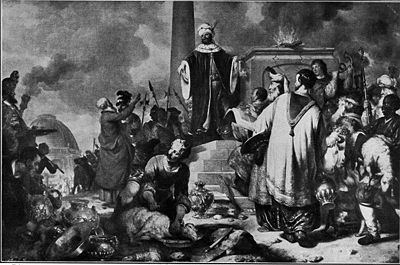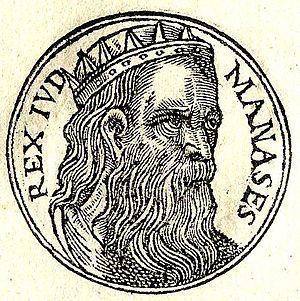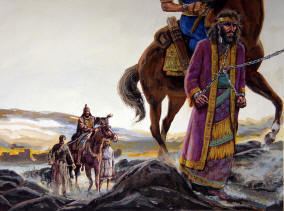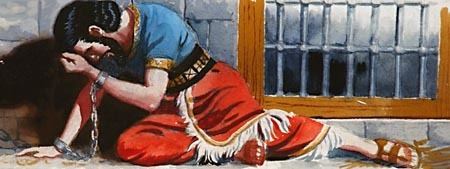Name Manasseh Judah | Issue Amon Role King Grandparents Ahaz, Abijah | |
 | ||
Reign coregency 697–687 BCsole reign687–643 BC Similar People Hezekiah, Josiah, Amon of Judah, Ahaz, David | ||
King manasseh of judah
Manasseh (; Hebrew: מְנַשֶּׁה Mənaššeh; Akkadian: Menašši (written me-na-si-i); Greek: Μανασσῆς Manassís; Latin: Manasses) was a king of the Kingdom of Judah. He was the only son of Hezekiah with Hephzibah. He became king at the age of 12 and reigned for 55 years (2 Kings 21:1; 2 Chronicles 33:1). Edwin Thiele has concluded that he commenced his reign as co-regent with his father Hezekiah in 697/696 BC, with his sole reign beginning in 687/686 BC and continuing until his death in 643/642 BC. William F. Albright has dated his reign from 687–642 BC.
Contents
- King manasseh of judah
- Relations with Assyria
- Olive oil trade
- Religious policies
- In other literature
- References

Manasseh was the first King of Judah who would not have had a direct experience with the Kingdom of Israel (Samaria), which had been destroyed by the Assyrians in c. 720 BC with much of its population deported. He re-instituted polytheistic worship and reversed the religious changes made by his father Hezekiah; for which he is condemned by several Biblical texts.

He was married to Meshullemeth, daughter of Haruz of Jotbah, and they had a son Amon, who succeeded him as king of Judah upon his death.

After a reign of 55 years (for 10 of which he was co-regent with his father), the longest in the history of Judah, he died in c. 643 BC and was buried in the garden of Uzza, the "garden of his own house" (2 Kings 21:17–18; 2 Chronicles 33:20), and not in the City of David, among his ancestors. The biblical account of Manasseh is found in II Kings 21:1–18 and II Chronicles 32:33–33:20. He is also mentioned in Jeremiah 15:4.

Relations with Assyria

When Manasseh's reign began, Sennacherib was king of Assyria, who reigned until 681 BC. Manasseh is mentioned in Assyrian records as a contemporary and loyal vassal of Sennacherib's son and successor, Esarhaddon. Assyrian records list Manasseh among twenty-two kings required to provide materials for Esarhaddon's building projects. Esarhaddon died in 669 BC and was succeeded by his son, Ashurbanipal, who also names Manasseh as one of a number of vassals who assisted his campaign against Egypt.

The Assyrian records are consistent with archaeological evidence of demographic trends and settlement patterns suggesting a period of stability in Judah during Manasseh's reign. Despite the criticisms of his religious policies in the biblical texts, archaeologists such as Israel Finkelstein and Neil Asher Silberman credit Manasseh with reviving Judah's rural economy, arguing that a possible Assyrian grant of most favoured nation status stimulated the creation of an export market. They argue that changes to the economic structure of the countryside would have required the cooperation of the 'countryside aristocracy', with restoration of worship at the high places a quid pro quo for this. Apparent devastation of the fertile Shephelah, coupled with growth of the population of the highlands and the southeast of the kingdom (especially in the Beersheba valley) during Manasseh's reign point to this possibility.
Olive oil trade

Olive oil production and export played a big role in the economy of the time. There's evidence in the Gaza area of entrepôt trade, and an apparently flourishing olive oil industry at Ekron. The construction or reconstruction of forts at sites such as Arad and Horvat Uza, explored by Nadav Na'aman and others, is also argued by Finkelstein and Silberman to be evidence in support of this thesis, as they would have been needed to protect the trade routes. However, Finkelstein and Silberman argue that the trade led to great disparities between rich and poor, which in turn gave rise to civil unrest. As a result, they speculate, the Deuteronomist author or editor of 2 Kings later reworked the traditions about Manasseh to portray his outward-looking involvement in trade as, effectively, apostasy.
Religious policies

There are three aspects of Manasseh's religious policy which the writer of Kings considered deplorable: the religious reaction which followed hard upon his accession; its extension by the free adoption of foreign cults; and the bitter persecution of the prophetic party.
According to Kings, Manasseh reversed the centralizing reforms of his father Hezekiah, and re-established local shrines, possibly for economic reasons. He restored polytheistic worship of Baal, and Asherah (2 Kings 21) in the Temple and sponsored the Assyrian astral cult throughout Judah. So zealous was he in his worship of the foreign gods, he even participated in the sacrificial cult of Moloch that consisted of sacrificing young children (Kings 2 21:6). His reign may be described as reactionary in relation to his father's; and Kings suggests that he may have executed supporters of his father's reforms. During Manasseh's half-century the popular worship was a medley of native and foreign cults, the influence of which was slow to disappear.
Such a reaction involved the persecution of those who had bitterly condemned the popular syncretism. The prophets were put to the sword (Jer. ii. 30). "Innocent blood" reddened the streets of Jerusalem. For many decades those who sympathized with prophetic ideas were in constant peril.
According to 2 Chronicles 33:11-13, Manasseh was on one occasion brought in chains to the Assyrian king, (possibly Esarhaddon), presumably for suspected disloyalty. The verse goes on to indicate that he was later treated well and restored to his throne. However, neither Kings nor Assyrian records mention this incident. The severity of Manasseh's imprisonment brought him to repentance. According to one of the two Biblical accounts (2 Kings 21 does not have the account of Manasseh's captivity or repentance), Manasseh was restored to the throne, (2 Chronicles 33:11–13) and abandoned idolatry, removing foreign idols (2 Chronicles 33:15) and enjoining the people to worship the Lord of Israel Yahweh.
In other literature
In rabbinic literature and Christian pseudepigrapha he is accused of executing the prophet Isaiah; according to Rabbinic Literature Isaiah was the maternal grandfather of Manasseh.
The Prayer of Manasseh, a penitential prayer attributed to Manasseh, appears in some Christian Bibles, but is considered apocryphal by Jews, Roman Catholics and Protestants.
